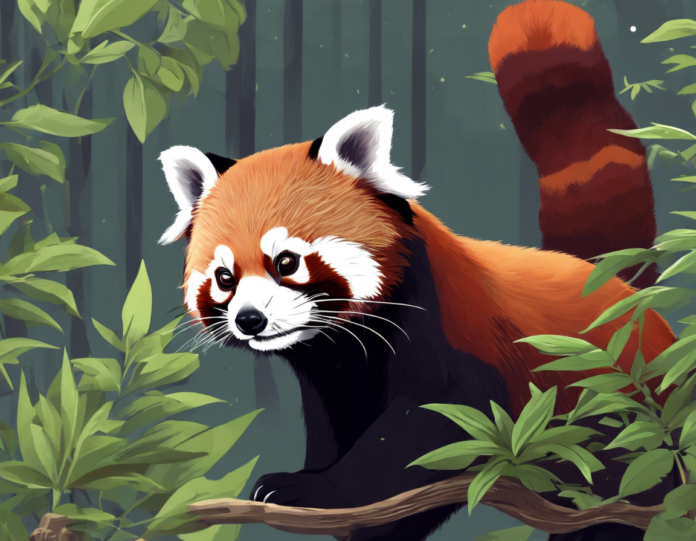Are you familiar with the red panda? Often overshadowed by its more famous distant cousin, the giant panda, the red panda is a fascinating and adorable creature that deserves more recognition. In this comprehensive guide, we will delve into the world of the red panda, exploring its habitat, behavior, diet, conservation status, and more. By the end of this article, you will have a newfound appreciation for this charming animal and understand why it is an integral part of our planet’s biodiversity.
Overview of the Red Panda
The red panda (Ailurus fulgens), also known as the lesser panda, is a small mammal native to the eastern Himalayas and southwestern China. It is easily recognizable by its rusty-red fur, white face, ringed tail, and adorable face. Despite its name, the red panda is not closely related to the giant panda and is classified in its own unique family, Ailuridae.
Habitat and Distribution
Red pandas are primarily found in the mountainous regions of Nepal, India, Bhutan, China, and Myanmar. They inhabit temperate forests with dense bamboo growth, as bamboo makes up a significant portion of their diet. These elusive creatures are well-adapted to arboreal life, spending most of their time in trees and using their long, bushy tails for balance.
Behavior and Diet
Red pandas are solitary animals, except during the breeding season. They are crepuscular, meaning they are most active during dawn and dusk. Red pandas are skilled climbers and spend the majority of their time foraging for bamboo, their primary food source. In addition to bamboo, they also consume fruits, acorns, eggs, and insects, showcasing their omnivorous diet.
Reproduction and Life Cycle
Red pandas typically breed in the early winter months, with gestation lasting around 3 months. Females give birth to 1-4 young, called cubs, in a secluded den. The mother provides care and protection for the cubs until they are old enough to fend for themselves. Young red pandas stay with their mothers for about a year before venturing off on their own.
Conservation Status
The red panda is classified as vulnerable by the International Union for Conservation of Nature (IUCN). Threats such as habitat loss, poaching, and climate change have contributed to the decline in red panda populations. Conservation efforts, including habitat protection, anti-poaching measures, and community education, are crucial for the survival of this species.
Interactions with Humans
Red pandas have long captured the hearts of people around the world with their playful antics and endearing appearance. Despite their popularity in zoos, these animals face numerous challenges in the wild. Responsible tourism, ethical wildlife viewing practices, and supporting organizations dedicated to red panda conservation are ways in which individuals can help protect these charismatic creatures.
Frequently Asked Questions (FAQs)
1. Are red pandas closely related to giant pandas?
No, despite the similar name, red pandas are not closely related to giant pandas. They belong to their own distinct family, Ailuridae, while giant pandas are classified in the family Ursidae.
2. What do red pandas eat?
Red pandas are primarily herbivores, with bamboo comprising the majority of their diet. They also consume fruits, acorns, eggs, and insects.
3. How many red pandas are left in the wild?
While precise numbers are challenging to determine, it is estimated that there are fewer than 10,000 mature red pandas left in the wild.
4. Why are red pandas endangered?
Red pandas are endangered due to habitat loss from deforestation, poaching for their fur, and climate change impacting their bamboo habitat.
5. Can red pandas be kept as pets?
No, red pandas are wild animals and should not be kept as pets. They require specialized care, habitat, and diets that are challenging to replicate in a home environment.
6. How can I help conserve red pandas?
You can help conserve red pandas by supporting organizations dedicated to their conservation, raising awareness about their plight, and promoting sustainable practices that protect their habitat.
7. Do red pandas have any natural predators?
Red pandas’ natural predators include snow leopards, martens, and birds of prey. Their elusive nature and climbing abilities help them avoid many predators.
8. Are red pandas aggressive towards humans?
Red pandas are typically docile animals and are not known to be aggressive towards humans. However, like any wild animal, they can become defensive if they feel threatened.
9. How long do red pandas live in captivity?
Red pandas can live up to 10-15 years in the wild, while they may live slightly longer, up to 18 years, in captivity under optimal conditions.
10. What unique adaptations do red pandas have?
Red pandas have a few unique adaptations, including an opposable “thumb” on each front paw that helps them grip bamboo, a specialized dietary strategy for digesting bamboo, and dense fur on the soles of their feet to protect against the cold.
In conclusion, the red panda is a truly special creature that enchants all who encounter it with its charm and beauty. By understanding the importance of red panda conservation and taking action to protect these animals and their habitats, we can ensure that future generations will have the opportunity to appreciate these captivating creatures in the wild.
